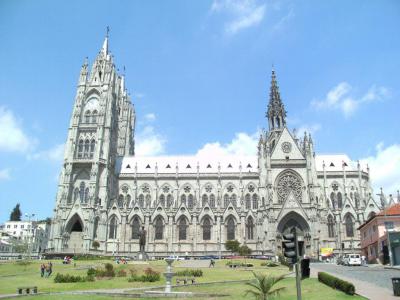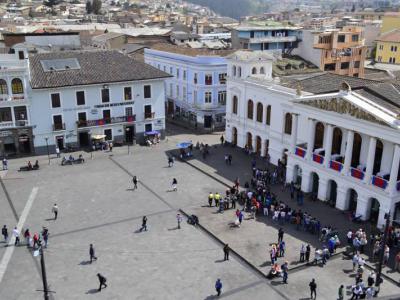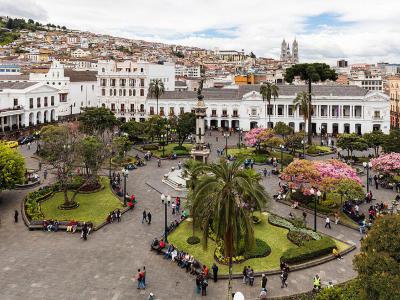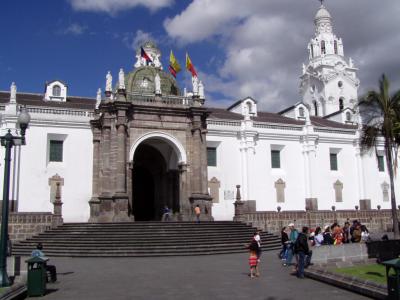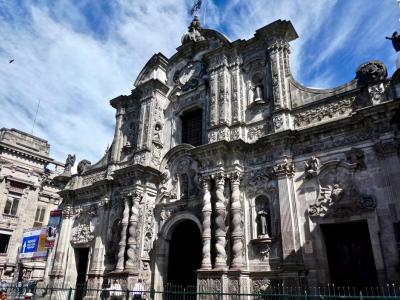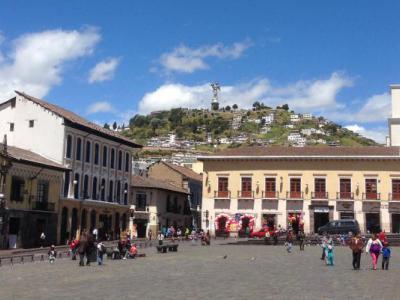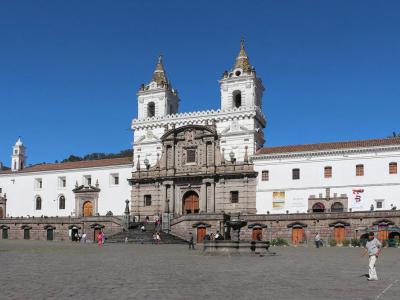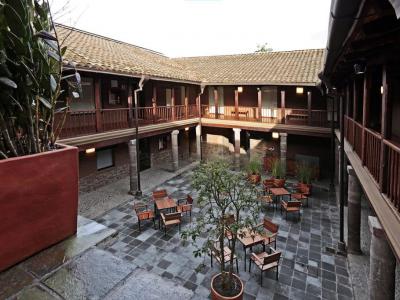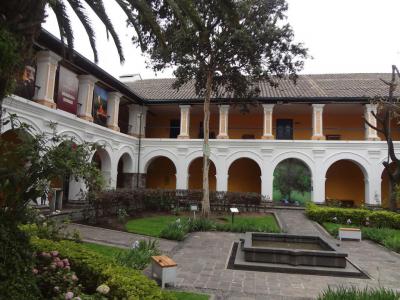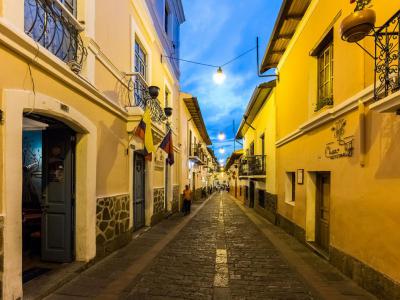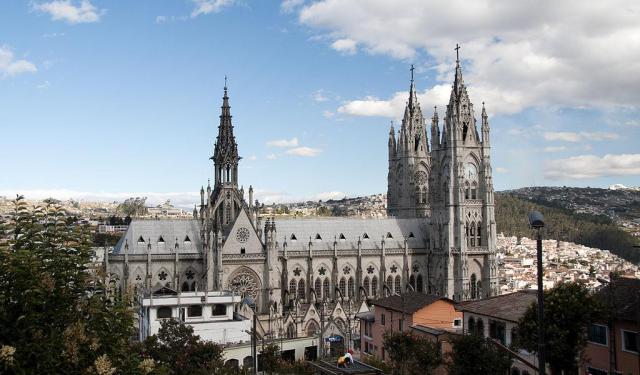Audio Guide: Quito Introduction Walking Tour (Self Guided), Quito
Born from Inca dreams and Spanish conquest, Quito stands high in the Andes—not just between valleys and volcanoes, but between worlds: indigenous, colonial, and modern.
Quito, the capital of Ecuador, is one of the oldest continuously inhabited cities in South America. Its name is believed to derive from the Quitus, an Indigenous group that lived in the area long before the Inca conquest. The word “Quito” is often interpreted as “the middle of the world,” reflecting its location just south of the equator and its historical role as a center of Andean civilization.
Archaeological evidence shows the region was settled as early as 2000 BCE by the Quitu people. By the 15th century, the Inca Empire expanded northward, incorporating the Quitu lands. Quito became an important administrative and military hub for the Incas. Yet during the Spanish conquest of the 1530s, Inca General Rumiñahui destroyed the city to keep it from falling into Spanish hands.
In 1534, the Spanish conquistador Sebastián de Belalcázar officially refounded Quito atop the ruins of the Inca settlement. Its strategic position in the Andes and role in regional trade quickly made it a thriving colonial city. The Spanish built churches, monasteries, and government buildings, many of which still stand today, giving Quito a reputation for some of the most well-preserved colonial architecture in the Americas.
By the late 18th and early 19th centuries, Quito had become a center of intellectual and political life. In 1809, it witnessed the first cry for independence in Latin America, inspiring uprisings across the continent. Ecuador ultimately achieved full independence in 1822 after the decisive Battle of Pichincha, fought just outside the city.
Today, Quito is a vibrant blend of ancient Indigenous traditions, colonial heritage, and modern urban life. Its historic center was among the first UNESCO World Heritage Sites, designated in 1978. Walking through the city’s cobblestone streets, visitors discover lively plazas, grand colonial architecture, and a city alive with culture.
Landmarks such as Independence Square, the Presidential Palace, and the ornate Church of the Society of Jesus showcase its rich history, while street vendors, cafés, and artisans add color and energy. Towering Andean hills provide a breathtaking backdrop to the historic heart of Quito, making every stroll an unforgettable experience.
As visitors wander these streets, it is easy to sense why Quito stands “in the middle of the world”—a city suspended between past and present, where every corner tells a story of dreams, resilience, and conquest.
Quito, the capital of Ecuador, is one of the oldest continuously inhabited cities in South America. Its name is believed to derive from the Quitus, an Indigenous group that lived in the area long before the Inca conquest. The word “Quito” is often interpreted as “the middle of the world,” reflecting its location just south of the equator and its historical role as a center of Andean civilization.
Archaeological evidence shows the region was settled as early as 2000 BCE by the Quitu people. By the 15th century, the Inca Empire expanded northward, incorporating the Quitu lands. Quito became an important administrative and military hub for the Incas. Yet during the Spanish conquest of the 1530s, Inca General Rumiñahui destroyed the city to keep it from falling into Spanish hands.
In 1534, the Spanish conquistador Sebastián de Belalcázar officially refounded Quito atop the ruins of the Inca settlement. Its strategic position in the Andes and role in regional trade quickly made it a thriving colonial city. The Spanish built churches, monasteries, and government buildings, many of which still stand today, giving Quito a reputation for some of the most well-preserved colonial architecture in the Americas.
By the late 18th and early 19th centuries, Quito had become a center of intellectual and political life. In 1809, it witnessed the first cry for independence in Latin America, inspiring uprisings across the continent. Ecuador ultimately achieved full independence in 1822 after the decisive Battle of Pichincha, fought just outside the city.
Today, Quito is a vibrant blend of ancient Indigenous traditions, colonial heritage, and modern urban life. Its historic center was among the first UNESCO World Heritage Sites, designated in 1978. Walking through the city’s cobblestone streets, visitors discover lively plazas, grand colonial architecture, and a city alive with culture.
Landmarks such as Independence Square, the Presidential Palace, and the ornate Church of the Society of Jesus showcase its rich history, while street vendors, cafés, and artisans add color and energy. Towering Andean hills provide a breathtaking backdrop to the historic heart of Quito, making every stroll an unforgettable experience.
As visitors wander these streets, it is easy to sense why Quito stands “in the middle of the world”—a city suspended between past and present, where every corner tells a story of dreams, resilience, and conquest.
How it works: Download the app "GPSmyCity: Walks in 1K+ Cities" from Apple App Store or Google Play Store to your mobile phone or tablet. The app turns your mobile device into a personal tour guide and its built-in GPS navigation functions guide you from one tour stop to next. The app works offline, so no data plan is needed when traveling abroad.
Quito Introduction Walking Tour Map
Guide Name: Quito Introduction Walking Tour
Guide Location: Ecuador » Quito (See other walking tours in Quito)
Guide Type: Self-guided Walking Tour (Sightseeing)
# of Attractions: 11
Tour Duration: 2 Hour(s)
Travel Distance: 2.4 Km or 1.5 Miles
Author: vickyc
Sight(s) Featured in This Guide:
Guide Location: Ecuador » Quito (See other walking tours in Quito)
Guide Type: Self-guided Walking Tour (Sightseeing)
# of Attractions: 11
Tour Duration: 2 Hour(s)
Travel Distance: 2.4 Km or 1.5 Miles
Author: vickyc
Sight(s) Featured in This Guide:
- Basilica del Voto Nacional (Basilica of the National Vow)
- Plaza del Teatro (Theater Square)
- Plaza de la Independencia (Independence Square)
- Palacio de Carondelet (Carondelet Palace)
- Catedral Metropolitana de Quito (Quito Cathedral)
- La Compania (Church of the Society of Jesus)
- Plaza de San Francisco (San Francisco Square)
- Iglesia de San Francisco (Church of San Francisco)
- Casa del Alabado (Precolumbian Art Museum)
- Museo de la Ciudad (Museum of the City)
- Calle de La Ronda (Round Street)
1) Basilica del Voto Nacional (Basilica of the National Vow) (must see)
At an altitude of 9,350 feet, Quito is the second-highest capital city in the world, surpassed only by La Paz, Bolivia. Yet even at this height, visitors will be tempted to climb to the top of the Basilica of the National Vow to take in its stunning panoramic views.
The idea for Quito’s most impressive Roman Catholic church was conceived in 1883, when congressman Father Julio Matovelle proposed building a monument to commemorate Ecuador’s consecration to the Sacred Heart of Jesus, the nation’s patron and protector. Construction began a year later, and the first stone was laid in 1892.
It took 30 years to build the Basilica, but it has not officially been completed. According to local legend, the world will end once the structure is finished. Located in the San Juan neighborhood, the Basilica stands 377 feet tall, making it the highest church in South America.
Designed in the Neo-Gothic style, the project was overseen by French architect Emilio Tarlier, who drew inspiration from Notre Dame in Paris and the Cathedral of Burgos in Spain. Ecuador’s Congress allocated 12,000 pesos for its construction. Surrounding the central nave are 24 chapels, each representing one of Ecuador’s provinces. Beneath the church lies an underground crypt and a pantheon where four Heads of State are buried.
Visiting the Basilica is an experience in itself. Guests can explore its intricate architecture on a self-guided tour and ascend even higher—by elevator or stairs—to the top floors, where a museum and café await. The real highlight, however, is the breathtaking view of Quito’s rooftops and surrounding Andean peaks from the tower, an unforgettable sight that captures the city’s grandeur.
The idea for Quito’s most impressive Roman Catholic church was conceived in 1883, when congressman Father Julio Matovelle proposed building a monument to commemorate Ecuador’s consecration to the Sacred Heart of Jesus, the nation’s patron and protector. Construction began a year later, and the first stone was laid in 1892.
It took 30 years to build the Basilica, but it has not officially been completed. According to local legend, the world will end once the structure is finished. Located in the San Juan neighborhood, the Basilica stands 377 feet tall, making it the highest church in South America.
Designed in the Neo-Gothic style, the project was overseen by French architect Emilio Tarlier, who drew inspiration from Notre Dame in Paris and the Cathedral of Burgos in Spain. Ecuador’s Congress allocated 12,000 pesos for its construction. Surrounding the central nave are 24 chapels, each representing one of Ecuador’s provinces. Beneath the church lies an underground crypt and a pantheon where four Heads of State are buried.
Visiting the Basilica is an experience in itself. Guests can explore its intricate architecture on a self-guided tour and ascend even higher—by elevator or stairs—to the top floors, where a museum and café await. The real highlight, however, is the breathtaking view of Quito’s rooftops and surrounding Andean peaks from the tower, an unforgettable sight that captures the city’s grandeur.
2) Plaza del Teatro (Theater Square)
Quito is a city steeped in history, and Theater Square offers a glimpse into its past. Before becoming a square, this site served as a marketplace, a bullring, and even a slaughterhouse, reflecting the evolving life of the city over centuries.
The square’s centerpiece is the Sucre National Theater, opened in 1886 and named after Antonio José de Sucre, a key leader in Quito’s liberation from Spanish rule in 1822. The theater is a medium-sized, prestigious venue featuring a Neoclassical façade with six Ionic columns. Inside, it hosts concerts, plays, and dance performances, offering visitors a chance to experience Quito’s vibrant cultural life.
Surrounding the square are cobblestone streets lined with shops, cafés, and colorful colonial buildings, creating a charming atmosphere for strolling and people-watching. Quito’s historic center, including Theater Square, is recognized as a UNESCO Cultural Heritage Site, highlighting its architectural and cultural significance.
Today, Theater Square remains a lively hub in the heart of the old town. Stopping for a coffee or enjoying a performance, visitors can soak in the history and energy of a space that has shaped Quito’s social and cultural life for centuries.
The square’s centerpiece is the Sucre National Theater, opened in 1886 and named after Antonio José de Sucre, a key leader in Quito’s liberation from Spanish rule in 1822. The theater is a medium-sized, prestigious venue featuring a Neoclassical façade with six Ionic columns. Inside, it hosts concerts, plays, and dance performances, offering visitors a chance to experience Quito’s vibrant cultural life.
Surrounding the square are cobblestone streets lined with shops, cafés, and colorful colonial buildings, creating a charming atmosphere for strolling and people-watching. Quito’s historic center, including Theater Square, is recognized as a UNESCO Cultural Heritage Site, highlighting its architectural and cultural significance.
Today, Theater Square remains a lively hub in the heart of the old town. Stopping for a coffee or enjoying a performance, visitors can soak in the history and energy of a space that has shaped Quito’s social and cultural life for centuries.
3) Plaza de la Independencia (Independence Square)
If you’re looking for the heart of Quito, Independence Square captures it. Established in the 18th century as a central meeting place, the square is surrounded by historic landmarks including the Carondelet Palace, the Metropolitan Cathedral of Quito, the Archbishop’s Palace, and the Municipal Palace. While the square itself is pedestrian-friendly, streets around it are open to vehicles.
Visitors can stroll along tree-lined paths, admire the fountains and the Independence Monument, or pause to take in the architecture around the Carondelet Palace. The Municipal Palace houses an Information Center where travelers can learn about the area’s history and available tours. Despite its modern design, the building complements the colonial architecture nearby.
Street vendors offer snacks and souvenirs, while side streets host cafés and Ecuadorian restaurants where visitors can sample local cuisine. The square’s atmosphere blends the city’s history, civic life, and everyday energy, providing a vivid glimpse of Quito’s social and cultural heart.
Visitors can stroll along tree-lined paths, admire the fountains and the Independence Monument, or pause to take in the architecture around the Carondelet Palace. The Municipal Palace houses an Information Center where travelers can learn about the area’s history and available tours. Despite its modern design, the building complements the colonial architecture nearby.
Street vendors offer snacks and souvenirs, while side streets host cafés and Ecuadorian restaurants where visitors can sample local cuisine. The square’s atmosphere blends the city’s history, civic life, and everyday energy, providing a vivid glimpse of Quito’s social and cultural heart.
4) Palacio de Carondelet (Carondelet Palace)
Located in Independence Square, the Carondelet Palace, also known as the Presidential Palace, serves as the seat of the Government of the Republic of Ecuador. The palace was formed by combining several buildings purchased by the Spanish crown. Its name, “Carondelet Palace,” was given by Simón Bolívar in 1822, who admired the elegance and austerity of the building during his visit.
Spanish architect Antonio García oversaw renovations under the direction of Barón Francisco de Carondelet, who also contributed to restoring other landmarks in the city, including the Cathedral. The work on the palace was officially completed in 1803.
Inside, a mural by the Ecuadorian artist Oswaldo Guayasamín, titled La Patria (The Homeland), depicts the struggles and resilience of the Ecuadorian and Latin American people.
During Rafael Correa’s presidency, the government declared the Carondelet Palace an Ecuadorian cultural heritage site and opened parts of the palace to the public as a museum. Visitors can explore the interior, view its decorative rooms, and see gifts presented to Ecuadorian presidents over the years. The experience offers a rich glimpse into Ecuador’s political history, architecture, and cultural heritage.
Tours of the palace typically last around 45 minutes. Tickets can often be obtained on the day of the visit, though reserving online in advance can help avoid lines, especially during busy periods.
Spanish architect Antonio García oversaw renovations under the direction of Barón Francisco de Carondelet, who also contributed to restoring other landmarks in the city, including the Cathedral. The work on the palace was officially completed in 1803.
Inside, a mural by the Ecuadorian artist Oswaldo Guayasamín, titled La Patria (The Homeland), depicts the struggles and resilience of the Ecuadorian and Latin American people.
During Rafael Correa’s presidency, the government declared the Carondelet Palace an Ecuadorian cultural heritage site and opened parts of the palace to the public as a museum. Visitors can explore the interior, view its decorative rooms, and see gifts presented to Ecuadorian presidents over the years. The experience offers a rich glimpse into Ecuador’s political history, architecture, and cultural heritage.
Tours of the palace typically last around 45 minutes. Tickets can often be obtained on the day of the visit, though reserving online in advance can help avoid lines, especially during busy periods.
5) Catedral Metropolitana de Quito (Quito Cathedral)
The Quito Metropolitan Cathedral, commonly known as Quito Cathedral, stands proudly on the southwestern side of Independence Plaza. Construction began in the mid-1550s under the guidance of the Spanish architect Antonio García, who oversaw the first two stages of the project. The cathedral was officially completed and consecrated in 1572 by Quito’s second bishop, Pedro de la Peña.
In 1660, the eruption of Mount Pichincha devastated the church, destroying large portions of the building. Reconstruction efforts restored and expanded the cathedral, with the work finally completed in 1806. The structure showcases an impressive blend of architectural styles, including Baroque, Moorish, Neoclassical, and Gothic elements. Inside, visitors can admire exquisite artwork by the renowned Ecuadorian sculptor Manuel Chili, better known as Caspicara.
From 1545 to 1848, the cathedral served as the seat of the Diocese of Quito. It became the city’s Archdiocese in 1848 and, in 1995, was officially recognized as the Cathedral of Ecuador, cementing its central role in the country’s religious life.
Quito Cathedral is also the final resting place of some of Ecuador’s most significant historical figures. These include Field Marshal Antonio José de Sucre, one of the liberators of Quito, Cardinal Carlos de la Torre, and several former presidents and bishops. Walking through the cathedral, visitors can feel the deep history and legacy of the city, from its colonial roots to its place at the heart of Ecuador’s spiritual and political life.
In 1660, the eruption of Mount Pichincha devastated the church, destroying large portions of the building. Reconstruction efforts restored and expanded the cathedral, with the work finally completed in 1806. The structure showcases an impressive blend of architectural styles, including Baroque, Moorish, Neoclassical, and Gothic elements. Inside, visitors can admire exquisite artwork by the renowned Ecuadorian sculptor Manuel Chili, better known as Caspicara.
From 1545 to 1848, the cathedral served as the seat of the Diocese of Quito. It became the city’s Archdiocese in 1848 and, in 1995, was officially recognized as the Cathedral of Ecuador, cementing its central role in the country’s religious life.
Quito Cathedral is also the final resting place of some of Ecuador’s most significant historical figures. These include Field Marshal Antonio José de Sucre, one of the liberators of Quito, Cardinal Carlos de la Torre, and several former presidents and bishops. Walking through the cathedral, visitors can feel the deep history and legacy of the city, from its colonial roots to its place at the heart of Ecuador’s spiritual and political life.
6) La Compania (Church of the Society of Jesus) (must see)
The Church of the Society of Jesus, located in Quito’s historic center, is a beautiful example of Spanish Baroque architecture. Construction began in 1605 under the direction of Jesuit architects and was completed over 160 years later.
The church reflects the influence of multiple architects over its long construction, blending different architectural styles, though Baroque dominates. Its interiors are adorned with gold leaf, covering walls, ceilings, the central nave, and domes—an effect that remains visually stunning despite earlier exaggerations of its volume. The main façade is carved entirely from volcanic stone, adding to the building’s grandeur.
Inside, visitors can admire 56 sculptures and 44 oil paintings. Notable works include Nicolás Javier de Goribar’s 16 Prophets, The Four Evangelists, and The Cardinals of the Society of Jesus, alongside sculptures by Bernardo de Legarda. Flanking the main entrance are paintings depicting Hell and the Final Judgment. The church also features representations of native flora and symbols of Ecuador’s ancestral peoples hidden within its pillars, as well as a historic organ dating back to 1889.
The church has been a site of important religious events. Pope John Paul II celebrated Mass here during his 1985 visit to Ecuador, and Pope Francis visited in 2015. Today, it stands as a remarkable testament to Quito’s colonial history, artistry, and religious heritage.
The church reflects the influence of multiple architects over its long construction, blending different architectural styles, though Baroque dominates. Its interiors are adorned with gold leaf, covering walls, ceilings, the central nave, and domes—an effect that remains visually stunning despite earlier exaggerations of its volume. The main façade is carved entirely from volcanic stone, adding to the building’s grandeur.
Inside, visitors can admire 56 sculptures and 44 oil paintings. Notable works include Nicolás Javier de Goribar’s 16 Prophets, The Four Evangelists, and The Cardinals of the Society of Jesus, alongside sculptures by Bernardo de Legarda. Flanking the main entrance are paintings depicting Hell and the Final Judgment. The church also features representations of native flora and symbols of Ecuador’s ancestral peoples hidden within its pillars, as well as a historic organ dating back to 1889.
The church has been a site of important religious events. Pope John Paul II celebrated Mass here during his 1985 visit to Ecuador, and Pope Francis visited in 2015. Today, it stands as a remarkable testament to Quito’s colonial history, artistry, and religious heritage.
7) Plaza de San Francisco (San Francisco Square)
In the Old Town sits cobbled San Francisco Square, one of the oldest and most beautiful sights in Quito. The dramatic San Francisco Church towers behind, making it one of the most Instagram-worthy squares in the city.
San Francisco Square previously served as a marketplace and an exchange point between chiefdoms during the Incan Empire. Huayna Capac, the Incan emperor, built his palace where the San Francisco Church sits today.
During the Spanish conquest of the Inca Empire, the Incans burned everything to the ground to prevent the Spanish from using the place and the Inca palace. The Spanish won, and to celebrate the victory, they renamed the plaza “San Francisco de Quito.”
San Francisco Square has a huge religious significance. The Jesus of the Great Power procession, which takes place on Good Friday, begins in the Square.
The Square’s majestic old town beauty attracts photographers, snapping photos early in the morning before the crowds come. Take a great photo from just about every angle!
In addition, visitors can enjoy Ecuadorian blackberry juice or an Ecuadorian pilsener beer at one of the cafés located here and watch many tourists and Quiteno people strolling along as they get on with their business, or visit an ancient brewery located in the square.
San Francisco Square previously served as a marketplace and an exchange point between chiefdoms during the Incan Empire. Huayna Capac, the Incan emperor, built his palace where the San Francisco Church sits today.
During the Spanish conquest of the Inca Empire, the Incans burned everything to the ground to prevent the Spanish from using the place and the Inca palace. The Spanish won, and to celebrate the victory, they renamed the plaza “San Francisco de Quito.”
San Francisco Square has a huge religious significance. The Jesus of the Great Power procession, which takes place on Good Friday, begins in the Square.
The Square’s majestic old town beauty attracts photographers, snapping photos early in the morning before the crowds come. Take a great photo from just about every angle!
In addition, visitors can enjoy Ecuadorian blackberry juice or an Ecuadorian pilsener beer at one of the cafés located here and watch many tourists and Quiteno people strolling along as they get on with their business, or visit an ancient brewery located in the square.
8) Iglesia de San Francisco (Church of San Francisco) (must see)
The dominant structure in San Francisco Square is the Church and Convent of San Francisco, designated a UNESCO World Heritage Site in 1978. Founded in 1534, it is Quito’s oldest and most significant religious site. Construction began in 1537, and while major portions were completed in the 16th century, work continued for more than 160 years, with the façade finished around 1680.
The vast complex includes three churches, thirteen cloisters for monks, a library containing historical documents, and a museum that holds over 3,500 pieces of religious art. It is regarded as the largest colonial architectural complex in the Americas.
Over the centuries, earthquakes have repeatedly damaged parts of the structure, requiring ongoing maintenance and restoration. In recognition of its cultural and architectural importance, it was included in the 2016 World Monuments Watch to support conservation efforts.
The church’s architecture blends Renaissance and Baroque elements on the exterior, while the interior reflects a fusion of Catholic and Indigenous artistic traditions. Today, the Church and Convent of San Francisco remain a major center of religious life and heritage in Quito, attracting hundreds of thousands of visitors each year.
The vast complex includes three churches, thirteen cloisters for monks, a library containing historical documents, and a museum that holds over 3,500 pieces of religious art. It is regarded as the largest colonial architectural complex in the Americas.
Over the centuries, earthquakes have repeatedly damaged parts of the structure, requiring ongoing maintenance and restoration. In recognition of its cultural and architectural importance, it was included in the 2016 World Monuments Watch to support conservation efforts.
The church’s architecture blends Renaissance and Baroque elements on the exterior, while the interior reflects a fusion of Catholic and Indigenous artistic traditions. Today, the Church and Convent of San Francisco remain a major center of religious life and heritage in Quito, attracting hundreds of thousands of visitors each year.
9) Casa del Alabado (Precolumbian Art Museum)
The Pre-Columbian Art Museum, housed in a beautifully preserved 17th-century colonial building, is a fascinating destination for history and anthropology enthusiasts. The museum was established to preserve and showcase the diverse Pre-Columbian cultures of Ecuador.
Its collection includes around 5,000 artifacts, some dating as far back as 4500 BCE, offering an immersive look into the artistic and spiritual life of the region’s ancient peoples. Each piece reveals the creativity and symbolic depth of Ecuador’s early cultures, from everyday objects to items used in sacred ceremonies.
Most of the artifacts are ceramics used in ceremonial and ritual contexts, representing cultures such as Valdivia, Jama-Coaque, and Chorrera. These are displayed across eight galleries, each dedicated to a specific theme or cultural tradition. Additional artifacts from other pre-Inca civilizations provide broader insight into Ecuador’s deep and diverse cultural heritage, illustrating the continuity and transformation of indigenous artistic traditions long before the rise of the Inca Empire.
A tour of the museum typically lasts between 45 minutes and an hour. Afterward, visitors can relax and enjoy food and wine at the charming café located in the museum’s courtyard.
Its collection includes around 5,000 artifacts, some dating as far back as 4500 BCE, offering an immersive look into the artistic and spiritual life of the region’s ancient peoples. Each piece reveals the creativity and symbolic depth of Ecuador’s early cultures, from everyday objects to items used in sacred ceremonies.
Most of the artifacts are ceramics used in ceremonial and ritual contexts, representing cultures such as Valdivia, Jama-Coaque, and Chorrera. These are displayed across eight galleries, each dedicated to a specific theme or cultural tradition. Additional artifacts from other pre-Inca civilizations provide broader insight into Ecuador’s deep and diverse cultural heritage, illustrating the continuity and transformation of indigenous artistic traditions long before the rise of the Inca Empire.
A tour of the museum typically lasts between 45 minutes and an hour. Afterward, visitors can relax and enjoy food and wine at the charming café located in the museum’s courtyard.
10) Museo de la Ciudad (Museum of the City)
The Museum of the City is the first museum in Quito to illustrate everyday life in the city through the centuries. It is housed in the former Old Saint John’s Hospital, a beautiful sixteenth-century building that is part of Quito’s UNESCO World Heritage zone.
In 1998, the historic hospital was transformed into a museum. Its impressive collection and diverse exhibitions explore local traditions, legends, cuisine, clothing, crafts, and daily activities, offering visitors a detailed picture of life in Quito over time.
In addition to pre-Columbian artifacts, the museum features rooms dedicated to the colonial period between 1500 and 1700, highlighting Spanish colonization and the influence of Catholicism on Ecuadorian culture.
A dedicated section explores the history of the Old Saint John’s Hospital, illustrating how diseases were treated and how medical care was provided to the city’s residents in past centuries.
In 1998, the historic hospital was transformed into a museum. Its impressive collection and diverse exhibitions explore local traditions, legends, cuisine, clothing, crafts, and daily activities, offering visitors a detailed picture of life in Quito over time.
In addition to pre-Columbian artifacts, the museum features rooms dedicated to the colonial period between 1500 and 1700, highlighting Spanish colonization and the influence of Catholicism on Ecuadorian culture.
A dedicated section explores the history of the Old Saint John’s Hospital, illustrating how diseases were treated and how medical care was provided to the city’s residents in past centuries.
11) Calle de La Ronda (Round Street) (must see)
After a day of sightseeing and taking in the city’s architectural sites, head to Round Street, one of the oldest streets in Quito. Here is where the tourists can get a glimpse of real Ecuadorian life. The area was once the home of artists and politicians, then transformed into what it is today: shops, bars, art galleries, cafés, and restaurants.
Round Street is said to be one of the oldest streets in Quito, and it has been nicely restored. There are houses built right next to each other, and inside, there are often small courtyards with gardens.
While strolling Ronda Street, sample the local alcoholic drink, canelazo, and also try authentic Ecuadorian cuisine from any of the elegant, or casual restaurants. For a quick snack, try humitas. Humitas is steamed ground corn wrapped in a corn husk. Have a cup of coffee with a traditional dessert, such as glazed figs or the Ecuadorian quesadilla, which is cheesecake with corn.
For entertainment, check out the street performers, such as the jugglers or musicians. Looking to dance? There is plenty of live Latin American music in Ronda Street's clubs and bars. For those who enjoy shopping, there are clothes and unique craftwork made by local artisans.
Round Street is said to be one of the oldest streets in Quito, and it has been nicely restored. There are houses built right next to each other, and inside, there are often small courtyards with gardens.
While strolling Ronda Street, sample the local alcoholic drink, canelazo, and also try authentic Ecuadorian cuisine from any of the elegant, or casual restaurants. For a quick snack, try humitas. Humitas is steamed ground corn wrapped in a corn husk. Have a cup of coffee with a traditional dessert, such as glazed figs or the Ecuadorian quesadilla, which is cheesecake with corn.
For entertainment, check out the street performers, such as the jugglers or musicians. Looking to dance? There is plenty of live Latin American music in Ronda Street's clubs and bars. For those who enjoy shopping, there are clothes and unique craftwork made by local artisans.
Walking Tours in Quito, Ecuador
Create Your Own Walk in Quito
Creating your own self-guided walk in Quito is easy and fun. Choose the city attractions that you want to see and a walk route map will be created just for you. You can even set your hotel as the start point of the walk.
Historical Religious Buildings Tour
As a former Spanish colony, Ecuador and its capital city Quito are home to literally dozens of Catholic churches. The Spaniards brought their faith into the new country and built many great temples here, some of which even pre-date the city of Quito itself.
Among the key local landmarks of ecclesiastical architecture is the Santo Domingo Church, dating back to the 16th century and showcasing a... view more
Tour Duration: 2 Hour(s)
Travel Distance: 2.7 Km or 1.7 Miles
Among the key local landmarks of ecclesiastical architecture is the Santo Domingo Church, dating back to the 16th century and showcasing a... view more
Tour Duration: 2 Hour(s)
Travel Distance: 2.7 Km or 1.7 Miles
The Most Popular Cities
/ view all



